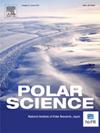Assessment and validation of Land Surface Temperature retrieval algorithms using Landsat 8 TIRS data in Antarctic ice-free areas
IF 1.5
4区 地球科学
Q3 ECOLOGY
引用次数: 0
Abstract
This study evaluates the effectiveness of different Land Surface Temperature (LST) retrieval algorithms applied to Landsat 8 Thermal Infrared Sensor (TIRS) data in the ice-free regions of the Antarctic Peninsula. The primary objective is to determine the most accurate algorithm for LST estimation in these environments. Three algorithms, namely radiative transfer equation (RTE), single channel (SC), and mono window (MW), were utilised and compared to in-situ measurements at two locations in the northern part of James Ross Island (JRI), Antarctic Peninsula. The study considered various factors influencing LST accuracy, including land surface emissivity, atmospheric conditions, and sun elevation angles. The findings reveal that all three algorithms demonstrate significant sensitivity to emissivity. The MW algorithm emerged as the most suitable, showing the lowest root mean square error (RMSE) of 3.06 °C, followed by the SC and RTE algorithms with RMSE values of 3.68 and 3.98 °C, respectively. The study also underscores a strong positive correlation between LST retrieval accuracy and sun elevation angle, with more accurate results obtained from satellite images acquired in February, characterised by lower sun elevation angles. No significant relationship with water vapour content in the atmosphere was identified during the investigated period.
基于Landsat 8 TIRS数据的南极无冰区地表温度反演算法评估与验证
本研究评估了不同地表温度(LST)检索算法在南极半岛无冰区Landsat 8热红外传感器(TIRS)数据中的有效性。主要目标是确定在这些环境中最准确的LST估计算法。利用辐射传输方程(RTE)、单通道(SC)和单窗口(MW)三种算法,对南极半岛詹姆斯罗斯岛(JRI)北部两个地点的原位测量结果进行了比较。该研究考虑了影响地表温度精度的各种因素,包括地表发射率、大气条件和太阳仰角。研究结果表明,这三种算法对发射率都具有显著的敏感性。MW算法的均方根误差(RMSE)最低,为3.06°C,其次是SC算法,RMSE分别为3.68°C和3.98°C。该研究还强调地表温度反演精度与太阳仰角之间存在很强的正相关关系,2月份获取的卫星图像获得的结果更准确,其特征是太阳仰角较低。在调查期间,未发现与大气中水蒸气含量有显著关系。
本文章由计算机程序翻译,如有差异,请以英文原文为准。
求助全文
约1分钟内获得全文
求助全文
来源期刊

Polar Science
ECOLOGY-GEOSCIENCES, MULTIDISCIPLINARY
CiteScore
3.90
自引率
5.60%
发文量
46
期刊介绍:
Polar Science is an international, peer-reviewed quarterly journal. It is dedicated to publishing original research articles for sciences relating to the polar regions of the Earth and other planets. Polar Science aims to cover 15 disciplines which are listed below; they cover most aspects of physical sciences, geosciences and life sciences, together with engineering and social sciences. Articles should attract the interest of broad polar science communities, and not be limited to the interests of those who work under specific research subjects. Polar Science also has an Open Archive whereby published articles are made freely available from ScienceDirect after an embargo period of 24 months from the date of publication.
- Space and upper atmosphere physics
- Atmospheric science/climatology
- Glaciology
- Oceanography/sea ice studies
- Geology/petrology
- Solid earth geophysics/seismology
- Marine Earth science
- Geomorphology/Cenozoic-Quaternary geology
- Meteoritics
- Terrestrial biology
- Marine biology
- Animal ecology
- Environment
- Polar Engineering
- Humanities and social sciences.
 求助内容:
求助内容: 应助结果提醒方式:
应助结果提醒方式:


